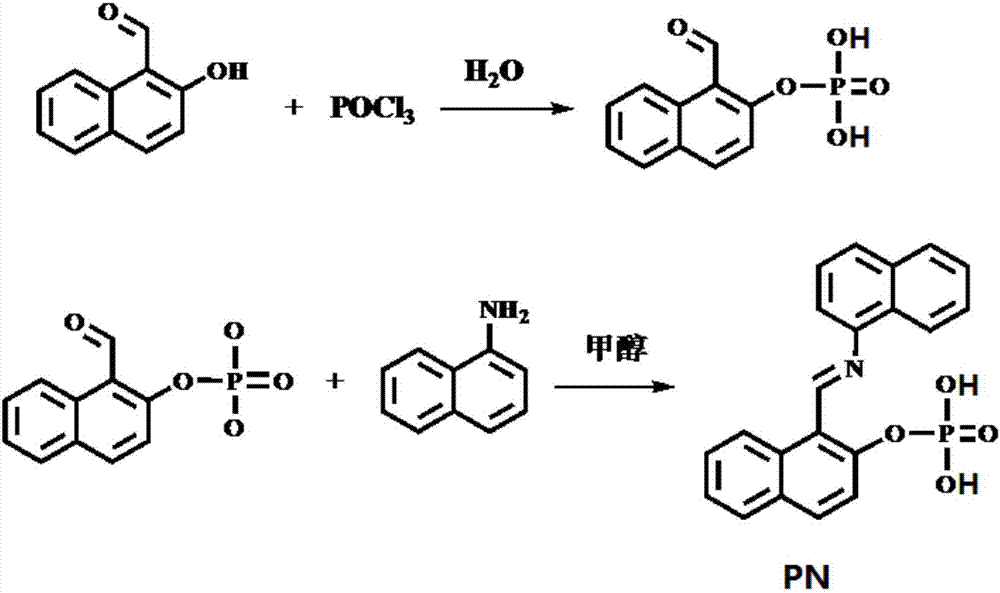Fluorescent probe for assaying alkaline phosphatase and preparation method thereof
A technology of fluorescent probes and phosphatases, applied in the direction of fluorescence/phosphorescence, chemical instruments and methods, luminescent materials, etc., can solve the problems of impracticality in the biological field, achieve short response time, strong anti-interference ability, and easy identification with naked eyes Effect
- Summary
- Abstract
- Description
- Claims
- Application Information
AI Technical Summary
Problems solved by technology
Method used
Image
Examples
Embodiment 1
[0024] Synthesis of fluorescent probe PN (synthetic route see figure 1 ):
[0025] Slowly add o-hydroxynaphthaldehyde (0.17g, 1.0mmol) into 20mL pyridine solution dissolved with phosphorus oxychloride (0.2mL, 2.0mmol), stir and react at room temperature in a round bottom flask for 4 hours; then pour the reaction solution into In a round-bottomed flask with 50 mL of ice water, continue to stir for 12 hours, filter, and separate by silica gel column chromatography to obtain compound 2-phosphonaphthaldehyde (0.25 g).
[0026] 1-aminonaphthalene (0.14g, 1.0mmol) and 2-phosphonaphthyl formaldehyde (0.25g, 1.0mmol) were heated to reflux in 20mL of methanol for 0.5 hours, cooled, filtered, washed, and separated by silica gel column chromatography to obtain the target compound PN (0.37g).
[0027] Characterized by electrospray mass spectrometry, it can be known that compound PN: experimental value m / z=375.3[M+H] + , theoretical value m / z=375.3[M+H] + (attached figure 2 ). NMR ...
Embodiment 2
[0029] The fluorescent probe PN can first realize the fluorescent response to alkaline phosphatase (ALP) in the solution in HEPES (pH 7.0) buffer solution, as shown in the attached image 3 . Add 2.0U / mL protein ALP, GDP, ACP, PDE, GAL, AChE, GoX and Trysin to 10μmol·L respectively -1 PN in HEPES (pH 7.0) buffer solution. attached by image 3 It can be seen that the addition of ALP makes the fluorescence of the solution at 523, 550 and 600 nm greatly enhanced (λ ex =480nm), the color of the solution gradually changed to orange. The addition of other common protein molecules GDP, ACP, PDE, GAL, AChE, GoX and Trysin basically does not affect the fluorescence intensity of the fluorescent probe PN, indicating that the probe PN has selective recognition of ALP in HEPES (pH 7.0) buffer solution Function, other common proteins will basically not interfere with the recognition of ALP. attached Figure 4 Fluorescence titration diagram of probe PN for different concentrations of A...
Embodiment 3
[0031] Probe PN can realize the sensing of endogenous ALP in cells. Figure 5 Middle a is a blank experiment without adding probes. Figure 5 In b, 10μmol·L -1 Probe PN and SW480cells were incubated in cell culture medium at 37°C for 0.5 hours. It can be clearly seen under the fluorescence microscope that the cells gradually emit orange fluorescence after adding the probe PN. Figure 5 where c and d are respectively Figure 5 Corresponding bright-field pictures of a and b. This experiment shows that the probe PN has a good fluorescence recognition function for endogenous ALP in cells.
PUM
 Login to View More
Login to View More Abstract
Description
Claims
Application Information
 Login to View More
Login to View More - R&D
- Intellectual Property
- Life Sciences
- Materials
- Tech Scout
- Unparalleled Data Quality
- Higher Quality Content
- 60% Fewer Hallucinations
Browse by: Latest US Patents, China's latest patents, Technical Efficacy Thesaurus, Application Domain, Technology Topic, Popular Technical Reports.
© 2025 PatSnap. All rights reserved.Legal|Privacy policy|Modern Slavery Act Transparency Statement|Sitemap|About US| Contact US: help@patsnap.com



